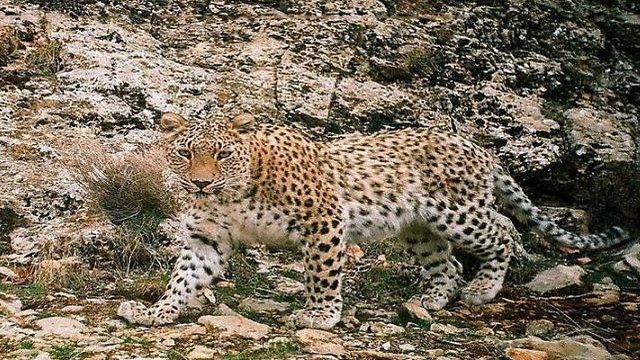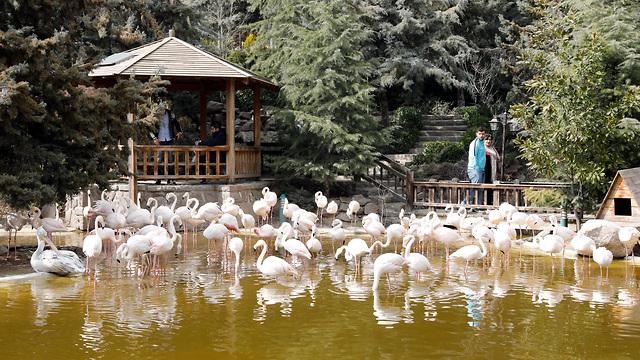
Flamingos at the Tehran Bird Garden in Iran (Photo: EPA)
Amid worsening diplomatic and economic isolation, Iran is continuing its crackdown on perceived dissidents including environmental scientists.
A recent Amnesty International report claimed the Islamic Republic arrested more than 7,000 rights activists in 2018—what the organization referred to as “Iran’s year of shame”—63 of them environmental researchers or related campaigners.
One high-profile example is the arrest last January by the Islamic Revolutionary Guard Corps (IRGC) of nine Iranian conservationists from the Persian Wildlife Heritage Foundation. Following nationwide anti-government protests, Iranian authorities accused the activists of espionage, claiming they were monitoring the country’s ballistic missile program using camera traps (remotely activated lenses typically used to film wild animals for research purposes).
The ecologists have remained in Iran’s notorious Evin prison for over a year. Last week, Tehran prosecutor-general Abbas Jafari Dolatabadi was quoted by state media as saying that their trial would take place soon, although he did not specify a date.
Nassim Papayianni, a member of Amnesty International’s Iran team, said that the defendants are accused of collecting classified information about Iran’s “strategic projects” and that “at least five have been charged with ‘(spreading) corruption on earth,’ which carries the death penalty.”
One of them, prominent environmentalist Kavous Seyed-Emami, died under suspicious circumstances a few weeks after being jailed. Iran’s judiciary holds that Seyed-Emami committed suicide whereas an autopsy report allegedly shows that he sustained injuries all over his body and was injected with an unknown substance. Meanwhile, his wife has been barred from leaving the country.
Niloufar Bayani, a graduate of McGill University, was among those detained and charged with spying. According to Canadian news outlets, Bayani was in Iran to set to up camera traps to monitor endangered Asiatic cheetahs.
In November, hundreds of conservationists, including renowned primatologist Jane Goodall, penned an open letter to Iranian Supreme Leader Ali Khamenei calling for the scientists to be released. Around the same time, a social media campaign with the hashtag #anyhopefornature was launched to draw attention to the matter.
According to Hadi Ghaemi, Executive Director at the Center for Human Rights in Iran (CHRI), the prisoners are being kept in solitary confinement and were forced to make false confessions under extreme duress.
Iranian authorities have so far failed to produce any evidence to justify the charges against them, Ghaemi said, adding that the Persian Wildlife Heritage Foundation was targeted specifically because it was “very successful in building international relations” with institutions abroad.
“Iran’s hardliners are very fearful of opening up the country,” he said. “This is really an attempt to prevent scientific (exploration).”
‘I was called a Mossad spy’
Dr. Kaveh Madani was briefly imprisoned in Iran last February, after President Hassan Rouhani convinced him to leave his post at London’s Imperial College to serve as deputy head of the country’s Department of Environment (DOE).During his short tenure, Madani succeeded in raising public awareness of the ecological problems in Iran; however, seven months after assuming his position and following the nationwide demonstrations he was forced to go into hiding with his family.
“I was called a bioterrorist, water terrorist and spy for MI6, Mossad and the CIA,” Madani wrote in an article detailing his ordeal on the New Scientist website. “The Revolutionary Guards even claimed I was manipulating the weather to create a drought.”
He eventually fled the Islamic Republic and is currently residing in the United States.
Many keep asking about the current status of the 8 #IranianEnvironmentalists who have been in "temporary detention" for more than a year. Here is the awful story of their first hearing.
— Kaveh Madani | کاوه مدنی (@KavehMadani) January 31, 2019
Conservation is not a crime!#ConservationistsAreNotSpieshttps://t.co/AUuuHyVaSf #GLBL301
“The love of nature is a feeling (the Iranian regime) doesn’t understand,” Madani says. “Instead, they like conspiracy theories and 007 stories. We are still confused, but the Revolutionary Guards think that (the scientists) were using camera traps to monitor missile and nuclear activities.”
In this respect, an Iranian conservationist who spoke to The Media Line on condition of anonymity claimed that some of the detained researchers did, in fact, stumble upon sensitive information.
“They found out about the secret bases that held lots of missiles,” the source said. “That was why they got arrested.”
Nevertheless, Papayianni of Amnesty International called on the international community to pressure Tehran to reverse what he described as a policy of tyranny against activists.
“The staggering scale of arrests and imprisonments reveal the extreme lengths the Iranian authorities are going to in order to suppress peaceful dissent. It is important that governments who are in dialogue with Iran to not stay silent while the net of repression continues to expand,” he said.
“These governments must speak out in the strongest terms against the crackdown and forcefully call on the Iranian authorities to immediately and unconditionally release all those jailed for peacefully expressing their right to freedom of expression, association and assembly, including through their human rights activism.”


















